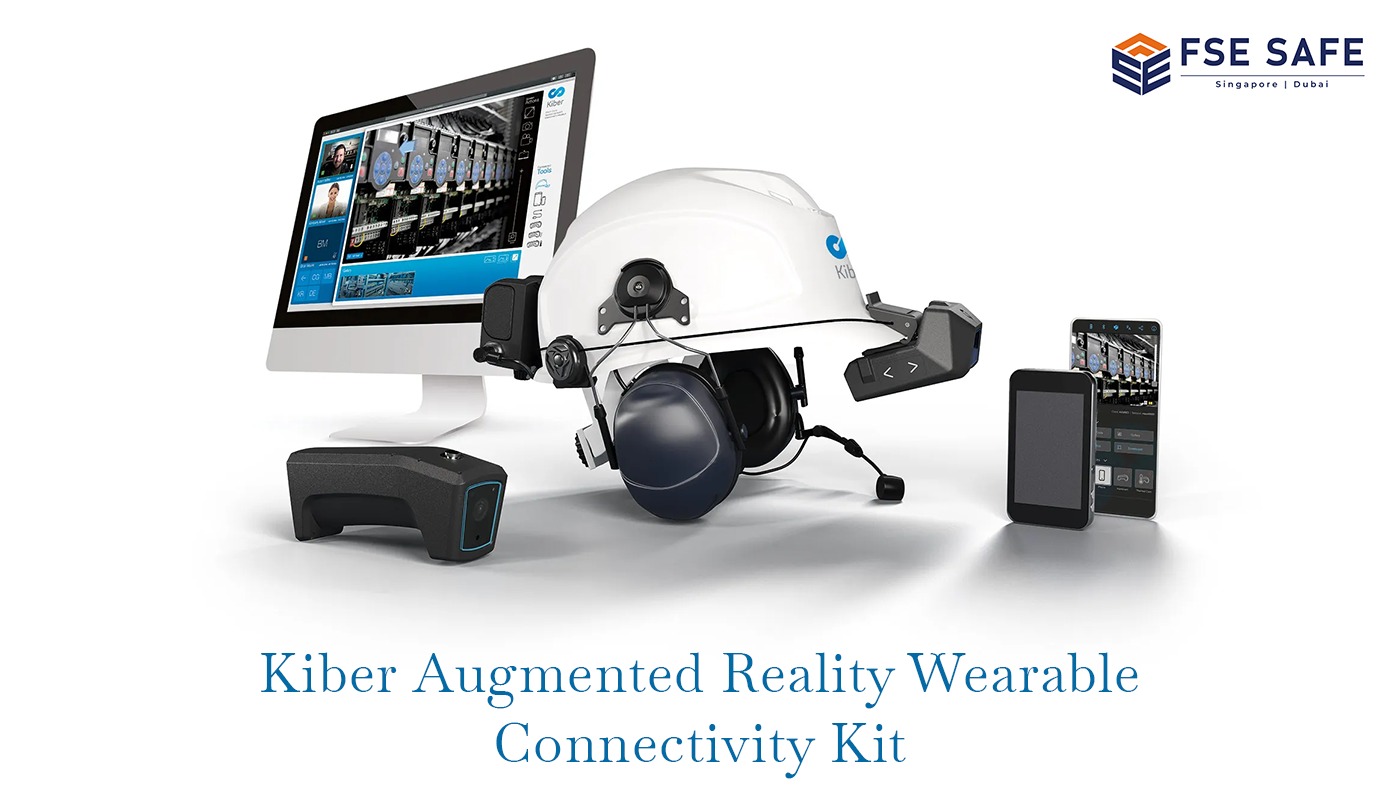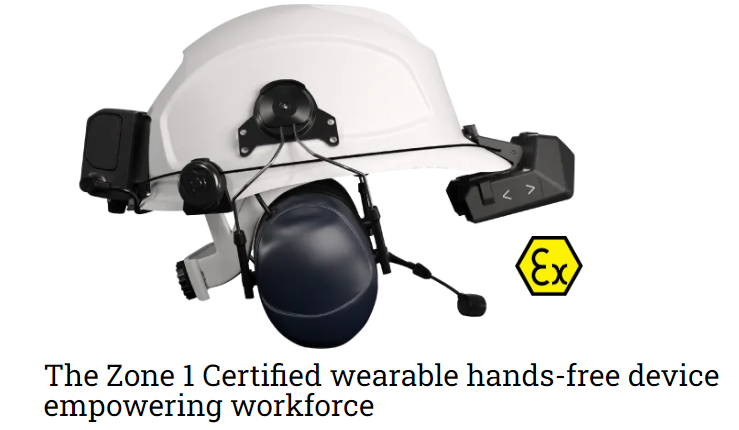Kiber presents a distinctive AR remote communication wearable solution that seamlessly integrates hardware and software. This innovative technology enables remote users to experience on-site situations as if they were physically present, while on-site workers can receive support without diverting their attention from their tasks, thanks to an all-in-one “hands-free” solution.
Kiber 3 Atex Kit for Tough Environments
Components of the Kit Include
- Headset (Helmet, noise-canceling hearing aid, noise-canceling microphone)
- Head Camera with a 150-degree field of view
- Visor
- Handcam
- Battery
- Connectivity device (optional)
- Hand watch (optional)
Kiber Kit Unboxing
Field Worker Wearable Kit: Equipping field workers with this wearable kit enables them to receive remote assistance through live video feeds. Augmented Reality technology enhances the field worker’s ability to capture the working environment, facilitating experts connected remotely to offer instructions, information, or any necessary remote support.
Connectivity for Remote Users: The AR wearable kit is internet-enabled, enabling field workers to establish a real-time connection with remote engineers and experts. Through dedicated desktop or mobile software, remote users can connect with field workers, accessing live feeds to guide, monitor, and manage remote assistance operations.
Real-Time Video Streaming: The head camera captures the worker’s point of view, streaming it in real-time to remote experts. This live video feed offers experts a clear perspective of the field worker’s surroundings.
Binocular Display: The worker can simultaneously observe the live stream and remote users in the meeting through the visor. The kit’s design enables the worker to seamlessly switch between reality and binocular streaming. When looking upwards, the streaming view from the binocular is visible, while looking straight allows the worker to perceive reality.
Interactive Communication: Field workers and remote experts can engage in two-way communication through audio and, at times, text or video chat. This fosters a dynamic exchange of information and expertise.
Remote Guidance: Experts can guide field workers through intricate tasks by visually demonstrating procedures, highlighting areas of interest in the worker’s field of view, or providing step-by-step instructions.
Data Exchange: Field workers can capture photos, videos, and other data, instantly sharing them with experts for analysis and decision-making. Remote experts can reciprocate by sharing images, videos, datasheets, and checklists.
Documentation Automation: The system can automatically record and document the field worker’s activities, creating a digital trail for quality control and auditing purposes
Training and Knowledge Transfer: AR wearables prove invaluable for training, enabling experts to deliver on-the-job training and transfer knowledge to less experienced workers.
Data Integration: The AR system seamlessly integrates with other enterprise systems, such as asset management or inventory databases, ensuring workers have access to real-time information.
Handcam Functionality: The Handcam serves as a practical tool for capturing images in hard-to-reach areas, such as behind equipment where workers may have difficulty reaching with their heads. The Handcam features zoom, flash, and thermal imaging options, enhancing its versatility.
The Main Benefits of Remote Visual Support
Remote Expertise Access: AR wearables empower field workers with real-time access to the knowledge and expertise of remote engineers and experts, streamlining problem resolution and minimizing the reliance on on-site specialists.
Enhanced Efficiency: AR wearables deliver real-time information, instructions, and guidance, significantly reducing task completion times and minimizing errors.
Training Advancements: Novice or less experienced workers can receive on-the-job training and guidance through AR wearables, enhancing their skills and knowledge.
Downtime Reduction: Faster problem-solving and information access translate to decreased downtime for machinery, equipment, and operations, leading to heightened productivity.
Safety Boost: AR provides real-time safety alerts and instructions, aiding workers in avoiding hazards and accidents.
Hands-Free Operation: Workers can access information and instructions without manual intervention, allowing them to concentrate on their tasks.
Documentation Excellence: AR wearables automatically record work processes, data, and images, proving invaluable for documentation, auditing, and quality control.
Remote Collaboration: Field workers can seamlessly collaborate with remote colleagues, enhancing communication and decision-making.
Data Visualization: AR offers real-time visualization of data, such as sensor readings or equipment status, facilitating workers’ comprehension of complex information. QR code scanning is also available.
Reduced Travel Costs: Experts can assist workers globally, reducing the necessity for travel to remote or challenging locations.
Maintenance and Repairs: Technicians can access real-time equipment manuals, schematics, and repair procedures, enhancing maintenance efficiency.
Customer Service Enhancement: In customer-facing industries, AR wearables provide employees with customer data and preferences, elevating the overall customer experience.
Quality Control: AR highlights quality control criteria, assisting workers in ensuring products meet stringent quality standards.
Inventory Management: Real-time access to inventory data improves control and reduces stockouts or overstock situations.
Data Analysis Tools: AR wearables equip workers with data analysis tools, facilitating on-the-spot, data-driven decision-making.
Adaptability: AR applications can be tailored for diverse industries and tasks, ensuring flexibility and applicability across various use cases.
Human Error Reduction: AR wearables, with step-by-step instructions and real-time guidance, mitigate the risk of human error in complex tasks.
Cost Savings: Over time, the integration of AR wearables leads to cost savings through heightened efficiency, reduced downtime, and optimized resource allocation.
Competitive Edge: Early adoption of AR wearable technology provides companies with a competitive advantage by offering superior service, increased productivity, and higher quality.
Environmental Impact: Reduced travel and enhanced efficiency contribute to lower carbon emissions and a smaller environmental footprint.
Versatile Applications Across Industries
- Inspection
- Maintenance
- Emergency Response
- Training
- Assistance
- Installation
For inquiries, contact FSE SAFE Projects Pte Ltd in Singapore at:
Email: [email protected]


